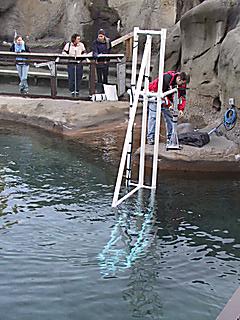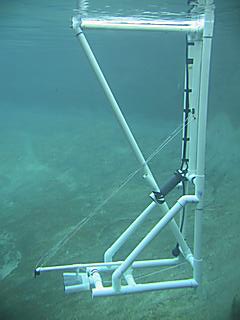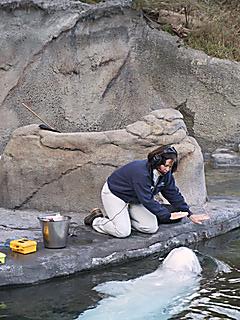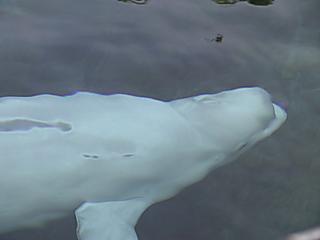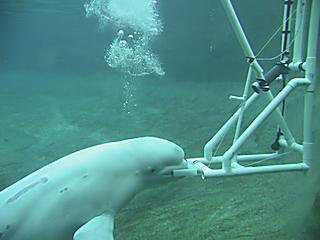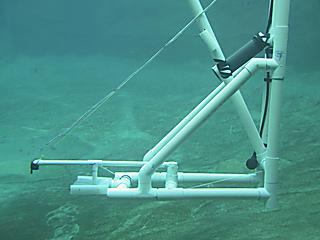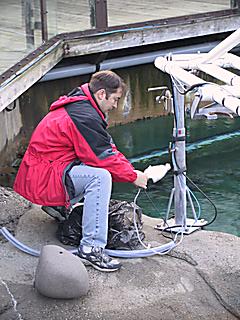Testing the Hearing of Marine Mammals
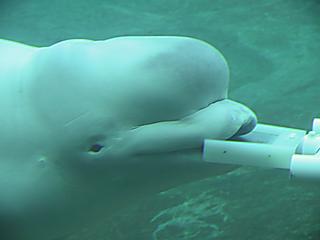
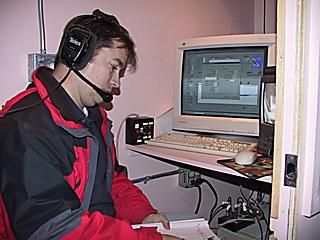
Testing the Hearing of Whales and Dolphins
Overview
Finding out how sensitive marine mammals are to sound is an essential first step to understanding how sound affects marine mammals. The hearing of some species of marine mammals has been tested. One approach to testing is to train individuals to respond to test tones with a specific behavior, which allows the tester to determine which tones have been heard and which were not heard. From repeated trials, researchers estimate the threshold of hearing at some frequency. Researchers do the same for a number of frequencies of test tones to find the audiogram of the subject.
The Noisy World of Sound in the Ocean
In 1953, Jacques Cousteau wrote a best-seller entitled, "The Silent World". Cousteau was mistaken: the oceans are filled with sound. The human ear underwater loses much of its sensitivity to sound. Humans are, effectively, partially deaf when they dive in the ocean.
Sound in the ocean comes from many different sources. Physical processes contribute to sound. Wave action results in sound, and different sea states have different levels of sound associated with them. Rain striking the water's surface adds sound. Seismic disturbances add sound to the ocean. Living creatures also contribute sound. Snapping shrimp stun their prey using a "pop" generated by a cavitation event made by a specialized claw. In some places in the world, the noise from snapping shrimp is a significant part of the total sound energy in the ocean. Some species of fish make sound, as even their common names make clear: drum and croaker. Perhaps most famously, marine mammals make sounds. Many of the toothed whales are known to use biosonar. Marine mammals may also use whistles and clicks for communication.
Whales and dolphins live in water, and the properties of water make hearing an important sense for these marine mammals. Sound travels further and faster in water than in air. When we start to look at how sound affects whales and dolphins, we need to know just how sensitive they are to sound in the water. We need to test their hearing.
The Challenge of Testing Hearing
The bottlenose dolphin (Tursiops truncatus) is a large mammal. White whales (Delphinapterus leucas) are even larger. Performing a hearing test on these animals poses a number of challenges.
For a behavioral audiogram, the subject is trained to make a response to an acoustic stimulus. The acoustic stimuli are given at many different frequencies and amplitudes, and an estimate is made of the
threshold of hearing for each frequency. When these values are plotted with frequency on the X axis and thresholds on the Y axis, this is called an audiogram. This approach contrasts with audiograms taken using electronics to pick up the faint signals of the brain's response to those stimuli, or neurophysiological audiograms. While the latter approach has the advantage of not being dependent on having trained subjects, it has the disadvantage of requiring even more sophisticated equipment and impeccable technique in order to carry it off.
A Case Study: Testing the Hearing of White Whales
The US Navy Marine Mammal Program and the Point Defiance Zoo and Aquarium jointly worked on testing the hearing of two white whales beginning in 2001. The goal there was to train two white whales so that a behavioral audiogram could be taken on each subject. Being able to obtain such audiograms is a first step in understanding the hearing of these marine mammals.
Experiments on marine mammals, even non-invasive procedures like taking a hearing test, require permits for keeping the animals under the Marine Mammal Protection Act and the approval of an Institutional Animal Care and Use Committee (IACUC). Before anything happens toward testing, the paperwork has to be done. When it comes to marine mammals, there is a lot of paperwork. A specific proposal and set of protocols for experiments is presented to an IACUC for review. IACUC's typically have a mix of technical (veterinarians and scientists) and non-technical members. Their job is to review the proposed work and make sure that it meets established standards of care for the animals.
Training the Whales: Once the IACUC approved the paperwork, then the trainers got to work. The trainers taught the white whales a number of behaviors. They taught them to whistle in response to a tone. They taught them to station on a platform by grasping a flat, rubber-covered bite plate with their mouth. They taught the whales to stay on the bite plate until the whales heard a bridging stimulus, and then return to the trainer. The trainers utilized operant conditioning techniques for teaching the white whales these behaviors. These are the same principles that are now being popularized in clicker training for dogs, and feature the use of positive reinforcement to train behaviors.
Setting up the Gear: When the whales had the basic behaviors in place, then the hearing tests could start. There is a lot of work involved in setting up for a hearing test.
What you see in the photos above is the hearing test platform being put into the water. The platform is constructed from PVC pipe, which distorts sound less than a metal framework work and also is less subject to corrosion. The platform's dimensions set fixed distances from various components to where the whale will be. The parts of interest in the photo showing an underwater view of the platform are the bite plate, where the whale will station; the projector, the small black ball toward the lower right; the hydrophone, which is attached to the boom at the lower left; and the underwater camera, a waterproof video camera aimed at the bite plate. The setup as shown in the photo on the right allows the operator to calibrate the acoustic equipment. In order to know what level of sound the subject will receive, a series of test tones are sent from the projector and picked up at the hydrophone. The hydrophone itself is calibrated beforehand using a device called a pistonphone. With the platform in place and the acoustic equipment calibrated, the hearing test is ready to begin.
In the picture above, the hearing test platform is made ready for the subject. The hydrophone on its boom is out of the way of the subject so that the subject can get to the bite plate.
Running a Hearing Test Session: A hearing test session requires the cooperation of the hearing test operator, a trainer, and a subject. In this case, the operator and trainer use intercom headsets to pass information. In addition, the hearing test computer is able to put information on a remote display unit so that the trainer can see useful information about the test.
After the Hearing Test: A number of things have to be done after the hearing test session is over. The hearing test system is calibrated again to make sure that the equipment has not changed during the course of the session. The operator has to analyze and archive the results from the session. The equipment has to be cleaned and stored away for the next session.
The Results: After all the testing is done, the result is that the researchers have an audiogram of the whale. This tells the researchers how sensitive the whale's hearing was at the time of testing.
Audiograms
The figure below shows reported hearing thresholds for bottlenose dolphins and white whales.

- (A) White whale from Johnson et al. (1989).
- (B) White whale from Awbrey et al. (1988).
- (C)&(D) White whale female and male from White et al. (1978).
- (E)&(F) White whale female and male from Ridgway et al. (2001).
- (G) Bottlenose dolphin from Johnson (1967).
Glossary
- Audiogram
- A graphical representation of hearing thresholds at several different frequencies showing the extent and sensitivity of hearing for a subject.
- Behavioral audiogram
- An audiogram which is obtained by having a subject respond with a specified behavior on hearing a sound.
- Calibration
- The process of measuring the response of equipment so that measurements taken can be related to standard units.
- Frequency
- The number of cycles or periods of a waveform of a tone that occur in one second.
- Neurophysiological audiogram
- An audiogram which is obtained by monitoring some aspect of a subject's brain function while sounds are presented to the subject. A common approach is to monitor the auditory brainstem response (ABR).
- Threshold
- The amplitude of a stimulus which is just perceptible by the subject. Statistically, a threshold is the amplitude such that the subject responds to half the trials at that amplitude.
References
Awbrey, W. A., Thomas, J. A., and Kastelein, R. A. (1988). “Low-frequency underwater hearing sensitivity in belugas, Delphinapterus leucas.”. Journal of the Acoustical Society of America 84, 2273–2275.
Egan, J. P., Greenberg, G. Z., and Schulman, A. I. (1961). “Operating characteristics, signal detectability, and the method of free response.”. Journal of the Acoustical Society of America 33(8 (Aug)), 993–1007.
Finneran, J. J., Carder, D. A., Ridgway, S. H., and Schlundt, C. E. (1999). “Technique for the generation and frequency compensation of bandlimited white noise and its application in studies of masked hearing thresholds”. Journal of the Acoustical Society of America 106, 2130(A).
Finneran, J. J., Schlundt, C. E., Carder, D. A., Clark, J. A., Young, J. A., Gaspin, J. R., and Ridgway, S. H. (2000). “Auditory and behavioral responses of bottlenose dolphins (Tursiops truncatus) and a beluga whale (Delphinapterus leucas) to impulsive sounds resembling distant signatures of underwater explosions”. Journal of the Acoustical Society of America 108(1), Jul 417–431.
Finneran, J. J., Schlundt, C. E., Dear, R., Carder, D. A., and Ridgway, S. H. (2002). “Temporary shift in masked hearing thresholds in odontocetes after exposure to single underwater impulses from a seismic watergun”. Journal of the Acoustical Society of America 111(6), 2929–2940.
Johnson, C. S. (1967). “Sound detection thresholds in marine mammals”, in Marine Bioacoustics, edited by W. N. Tavolga (Pergamon, New York), volume 2, pp. 247–260.
Johnson, C. S., McManus, M. W., and Skaar, D. (1989). “Masked Tonal Hearing Thresholds in the Beluga Whale”. Journal of Acoustical Society of America 85(6), 2651–2654.
Ridgway, S. H. and Carder, D. A. (1997). “Hearing deficits measured in some Tursiops truncatus, and discovery of a deaf/mute dolphin”. Journal of the Acoustical Society of America 101, 590–594.
Ridgway, S. H., Carder, D. A., Kamolnick, T., Smith, R. R., Schlundt, C. E., and Elsberry, W. R. (2001). “Hearing and whistling in the deep sea: depth influences whistle spectra but does not attenuate hearing by white whales (Delphinapterus leucas) (Odontoceti, Cetacea)”. Journal of Experimental Biology 204(22), 3829– 3841.
Ridgway, S. H., Carder, D. A., Smith, R. R., Kamolmick, T., Schlundt, C. E., and Elsberry, W. R. (1997). “Behavioral Responses and Temporary Shift in Masked Hearing Threshold of Bottlenose Dolphins, Tursiops truncatus, to 1-second Tones of 141 to 201 dB re 1 µPa.”. Technical Report 1751, Naval Command, Control and Ocean Surveilance Center, RDT&E Division.
Schlundt, C. E., Finneran, J. J., Carder, D. A., and Ridgway, S. H. (2000). “Temporary shift in masked hearing thresholds (MTTS) of bottlenose dolphins, Tursiops truncatus, and white whales, Delphinapterus leucas, after exposure to intense tones.”. Journal of the Acoustical Society of America 107(6), 3496–3508.
White, Jr., M. J., Norris, J., Ljungblad, D., Baron, K., and di Sciara, G. (1978). “Auditory thresholds of two beluga whales (Delphinapterus leucas)”. for U. S. Naval Ocean System Center HSWRT Tech. Rep. 78-109 or 78-108, Hubbs/Sea World Research Institute Technical Report 78-101.
See Also...
- Bottlenose Dolphin Biosonar Click Cards!
- A handy teaching tool for those looking at the properties of dolphin echolocation. This PDF will print a sheet of business-card sized handouts showing the waveform of a dolphin click at the same scale as it would have propagating through sea water. The distance sound travels in 58 microseconds in sea water is the width of a business card, and a dolphin biosonar click fits nicely within that scale.
Page Information
by Wesley R. Elsberry and Diane J. Blackwood. Wesley and Diane are wildlife biologists who have done research on the hearing, biosonar, and physiology of marine mammals.
Page created 2003/09/09, last updated 2003/11/04



